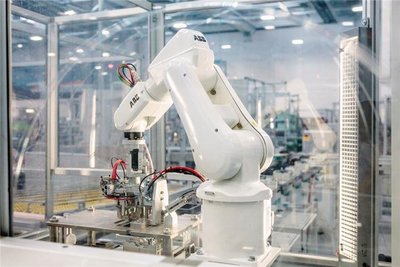ABB putting its own technology to work
Tuesday, 04 March, 2014
In a good example of an automation company taking advantage of its own technology, ABB has implemented its own robots to streamline the designing, developing and manufacturing of low-voltage circuit-breakers at ABB SACE’s Frosinone plant in Italy. This is not a new development, but a progressive deployment over a number of years that has enabled the manufacturer to gradually reduce costs and increase efficiency dramatically.
The Frosinone facility, 90 minutes south of Rome, has been producing core components and performing final assembly of electronic and thermomagnetic low-voltage circuit-breakers since 1988. In 1993, two ABB robots joined the production line to handle soldering tasks, but it was not until 2000 that Frosinone decided to more aggressively take advantage of robotic capabilities.

Two SACE Division engineers - Savina Fardelli, Production Engineering Manager, low-voltage breakers, and Marco Dolce, Process Engineering Manager - decided to rethink the entire system of production, using robots to make it more efficient with lower costs and improved quality.
“We can reconfigure the shapes and sizes of our products very easily because of the flexibility of the robots,” Fardelli says. “We can also introduce new lines quickly and at a lower cost by retraining our existing workers.”
It was in 2000 that an IRB 140 robot arrived at the plant to be put to work on the packaging line. Fardelli and Dolce decided that the robot (and all the others to follow) should be painted white rather than the traditional ABB orange. “We wanted to communicate a sense of cleanliness, luminosity and surgical precision,” says Fardelli of the decision.
In 2006, more robots were added to handle soldering, packaging and assembly tasks. Four years later other welding robots arrived. By the end of 2012, more than 40 ABB robots were working in Frosinone. Half of them perform welding and assembly functions, and the rest work in a variety of roles including quality control, testing, packaging and pick-and-place applications.
Since the robots were installed, cost benefits have been clearly evident. As of 2000, production at Frosinone has more than doubled without an increase in the number of employees. That year the plant produced around one million low-voltage case circuit-breakers. Today, it produces 2.5 million moulded case circuit-breakers plus another 75,000 air circuit-breakers.
Over the same period, there have also been no lay-offs. Workers who formerly handled simple tasks now have more sophisticated assignments, and training is an on-going process. Additionally, because robots make less noise than non-robot automated systems, the overall sound level is more manageable for the humans who work alongside them.
And the advantages go beyond increased output, maximised manpower and decreased noise; there are time benefits as well. As Dolce points out, the design of an automated non-robot system may require three engineers and considerable time to construct the necessary equipment. A robot line requires one programmer and, at maximum, a few days to develop the appropriate production-line structure.
Lowering the number of product rejects is another of the engineers’ main cost-saving goals. In fact, their aim is to reduce rejections from three per cent to zero through an increased use of robots. “Our main focus is to lower the cost of our product without sacrificing quality,” says Dolce.
The robots are also compact, saving valuable space and energy on the factory floor. For example, after introducing an IRB 120 robot, space requirements on the floor shrank from 200 to 50 square metres. And, because of its efficiency, a robotic-based production line consumes 30% less energy.
Speed, a valued feature of the robots, is not as important for circuit-breaker production as it is for, say, high-volume consumer products. The robots at Frosinone are not used at their full speed because precision and accuracy are emphasised, and flexibility is paramount in the cost-saving equation. In an ongoing effort to keep product quality up and lower costs, Dolce and Fardelli are currently working on a new assembly line featuring robots that will be up and running in early 2014.
ABB identifies new frontiers for robotics and AI in 2024
Accelerating progress in AI is redefining what is possible with industrial robotics.
The need for speed
The constant improvements by CPU manufacturers are providing new processing techniques that...
IPCs enhance warehouse automation
A Sydney distribution centre has enhanced its operational efficiency with an innovative system...














